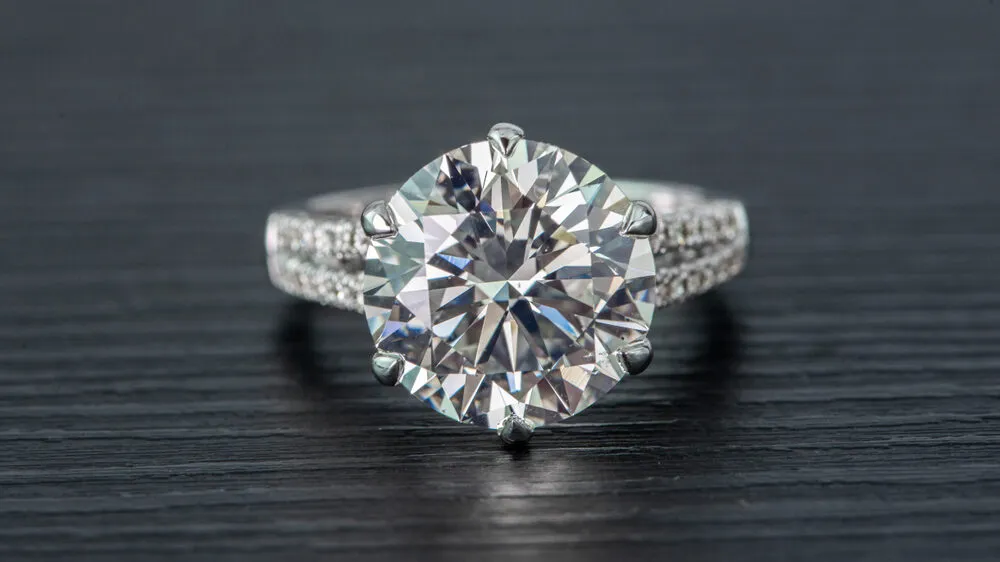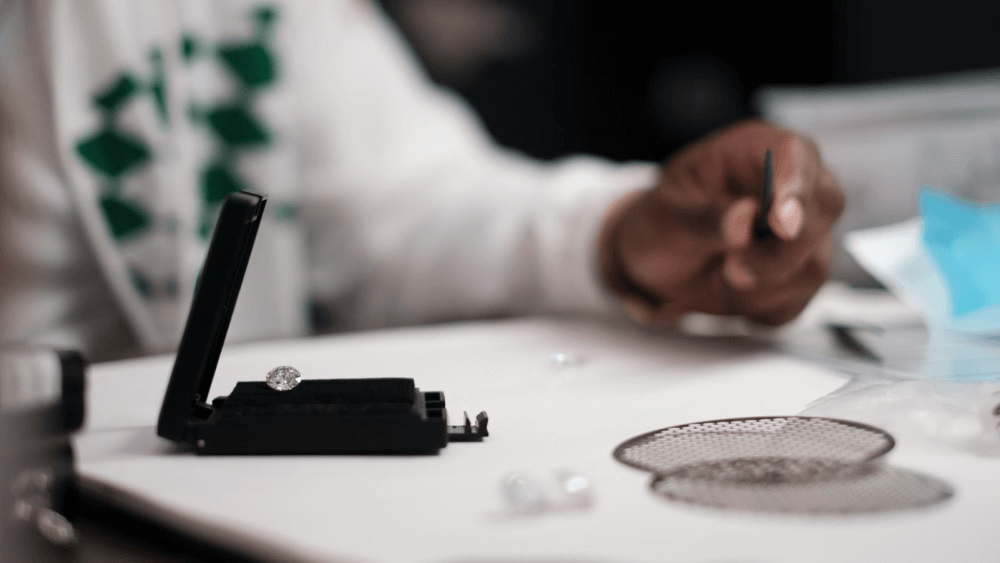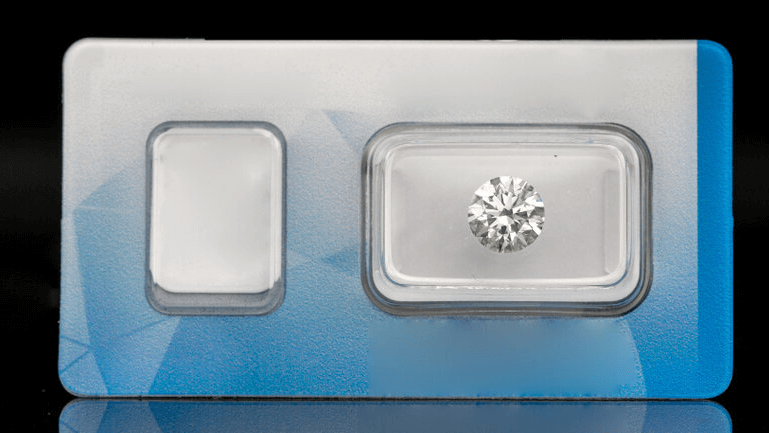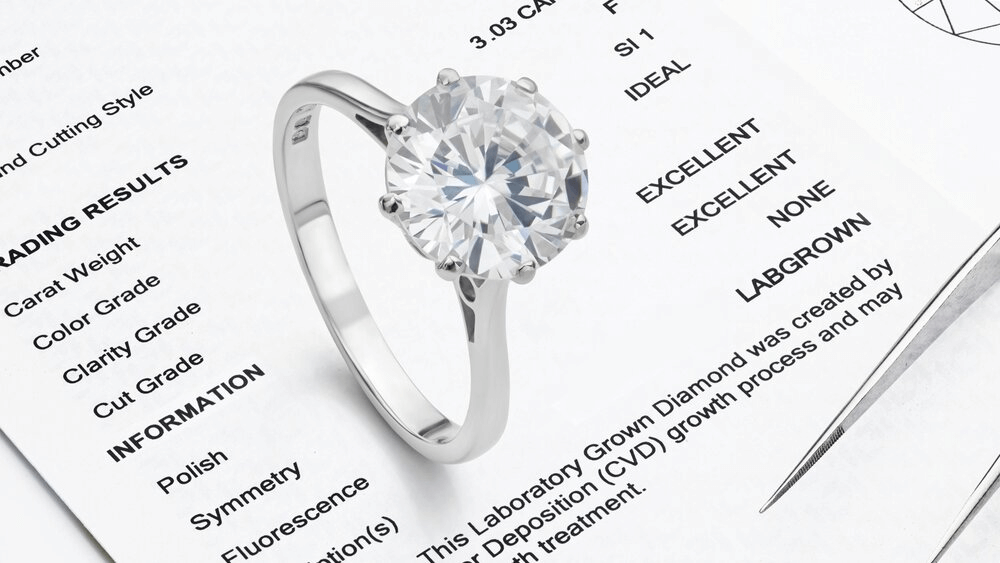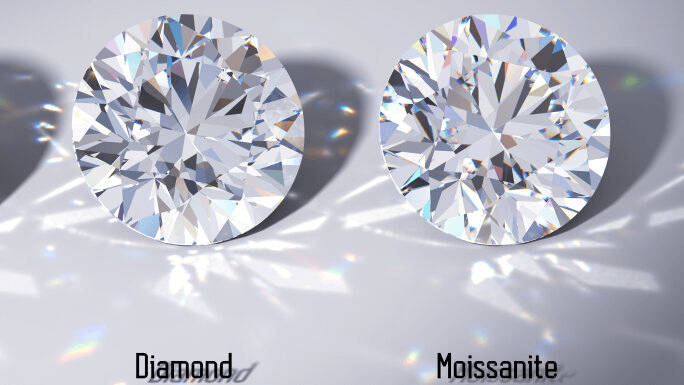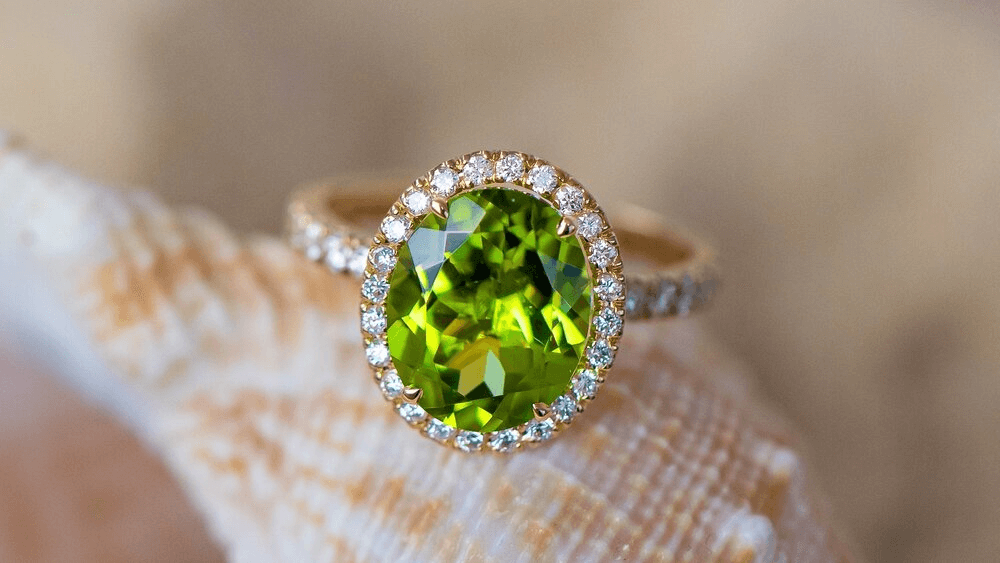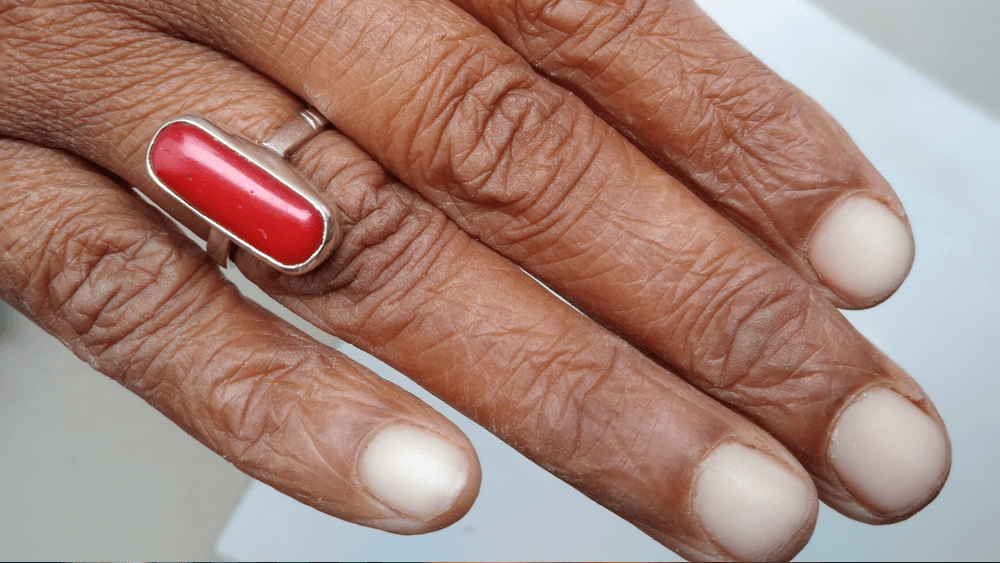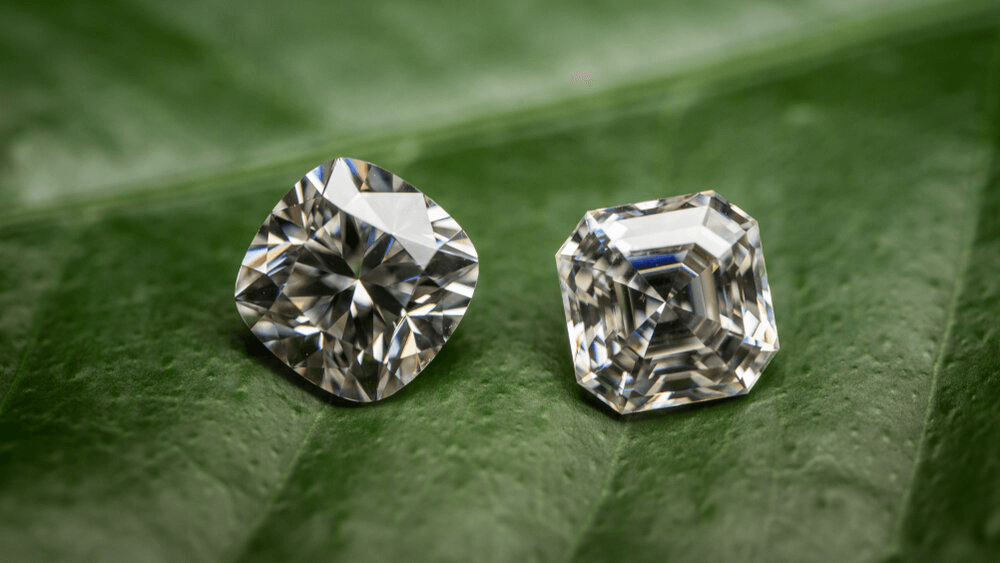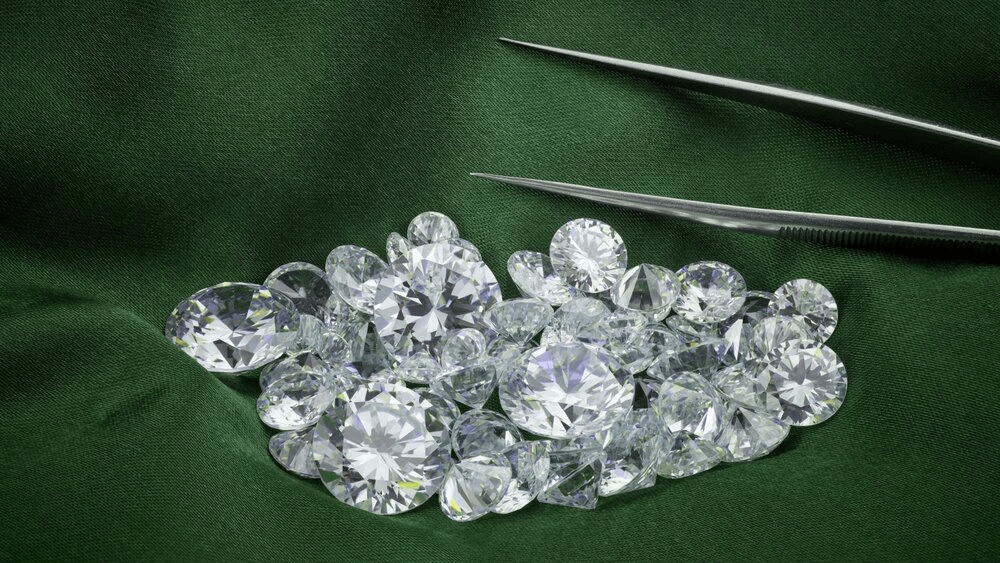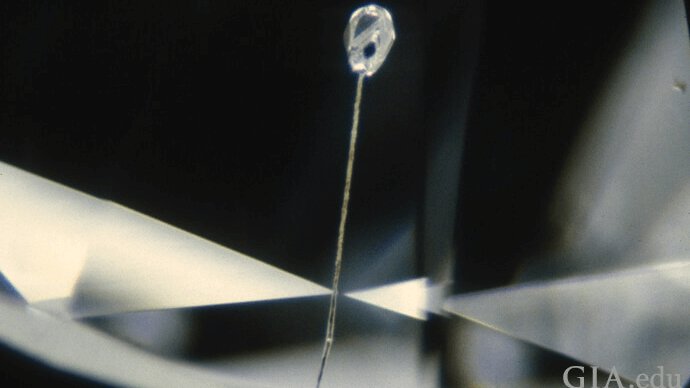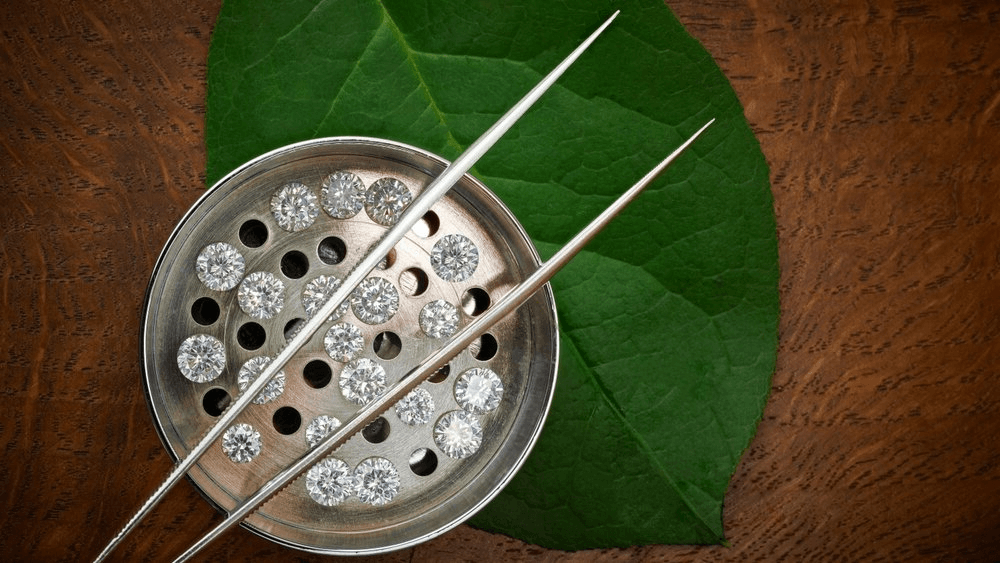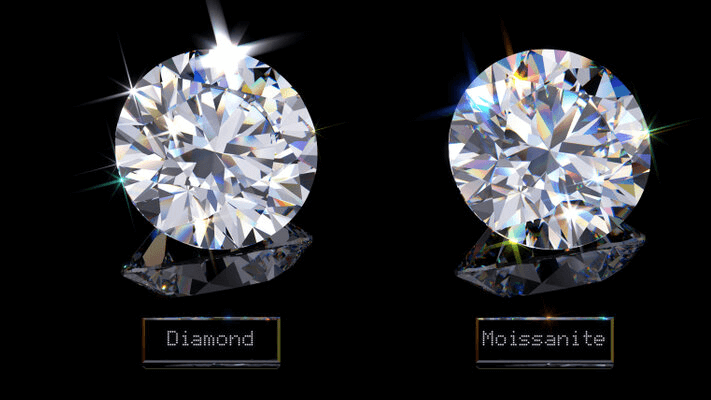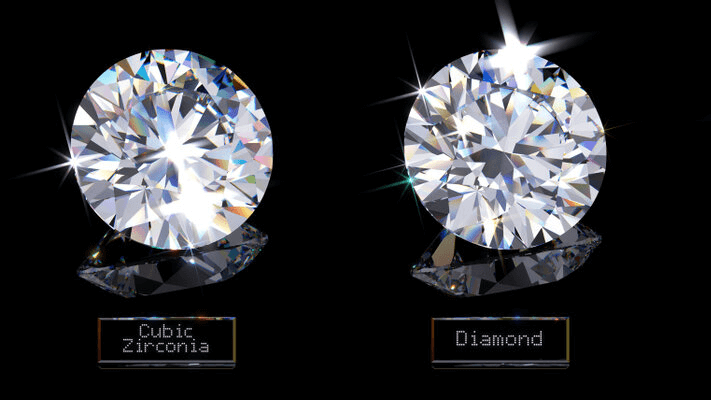Simulated vs. Real Diamonds: Decoding Their Brilliance!

By Gary A.

Edited by Olivia H.
Published Mar 26, 2022
Edited on Dec 18, 2024
For those seeking an affordable yet stunning option, diamond alternatives like lab-grown diamonds, moissanite, and cubic zirconia offer brilliance without the hefty price tag.

Navigate This Guide:
- 9 Quick Tips for Buying a Diamond or Simulant for Your Engagement Ring: Moissanite vs Diamond vs Cubic Zirconia
- Introduction
- Understanding Diamond Alternatives
- Comparing Diamond Simulants
- Price Considerations
- Our Expert Take
- 8 FAQs
Before we dive deeper into the specifics, here are some practical tips to help guide your decision-making process:
9 Quick Tips for Buying a Diamond or Simulant for Your Engagement Ring: Moissanite vs Diamond vs Cubic Zirconia
When selecting a diamond engagement ring, especially when comparing moissanite, diamonds, and cubic zirconia, it’s crucial to consider several practical aspects. Here’s a guide to help you make an informed decision:
- Tip 1: Understand the Differences in Hardness and Durability: Diamonds are the hardest known mineral and are incredibly durable. Moissanite comes close but is slightly less hard, while cubic zirconia is much softer and prone to scratches. Pay attention to the Mohs scale rating: Diamonds score a perfect 10, moissanite around 9.25, and cubic zirconia between 8-8.5. Consider your lifestyle: If the ring will be worn daily and exposed to rough conditions, a diamond might be the best choice for longevity.
- Tip 2: Examine the Brilliance and Fire: Diamonds are known for their high brilliance and balanced dispersion of light. Moissanite tends to exhibit more fire (rainbow colors) than diamonds, which can be a telltale sign when comparing. Cubic zirconia, while sparkly, often lacks the depth of brilliance found in diamonds and moissanite. Look at the stones under different lighting conditions to observe how they reflect light.
- Tip 3: Assess the Clarity and Color: Inspect the stone for any inclusions or blemishes. Diamonds come in varying clarity grades, while moissanite and cubic zirconia are often eye-clean. Diamonds can range from colorless to yellowish, with colorless being more valuable. Moissanite may have a slight yellow or green tint in certain lights, while cubic zirconia is typically colorless. Be aware that larger sizes in moissanite and cubic zirconia can sometimes make color differences more apparent.
- Tip 4: Consider the Weight and Size Comparison: Remember that moissanite and cubic zirconia are denser than diamonds. A 1-carat moissanite or cubic zirconia will be smaller in size compared to a 1-carat diamond. Decide whether size or quality is more important for your budget. Larger moissanite or cubic zirconia stones can mimic the appearance of a big diamond at a lower cost.
- Tip 5: Check for Authenticity and Certification: While shopping, ensure that diamonds come with a certification from a reputable lab such as GIA or AGS. For moissanite and cubic zirconia, certifications aren’t as common, but reputable sellers should provide guarantees of quality and composition.
- Tip 6: Reflect on Long-Term Value and Resale: Diamonds generally hold their value over time and can be resold. Moissanite and cubic zirconia have significantly lower resale values. Consider the ring as both an emotional and financial investment. While synthetic options are budget-friendly, they might not appreciate in value like diamonds.
- Tip 7: Learn to Identify Visual Characteristics: Real diamonds often exhibit unique internal characteristics called inclusions and slight color variations. Simulated diamonds like cubic zirconia and moissanite are usually flawless and colorless, which can be a clue to their synthetic nature. Examine the stone’s brilliance (white light reflection) and fire (dispersion of light into colors). Real diamonds have a balanced brilliance and fire, while simulants may exhibit exaggerated fire or less brilliance.
- Tip 8: Check Refractive Index and Light Performance: The refractive index, which affects how light travels through the stone, differs between real and simulated diamonds. This difference influences the stone’s sparkle and the way light is bent and reflected. Real diamonds refract light uniquely, often allowing you to see through them at certain angles. Simulated diamonds, on the other hand, may either over-disperse light, creating a “disco-ball” effect, or underperform in sparkle.
- Tip 9: Research Pricing and Affordability: Understand that real diamonds command a higher price due to their natural rarity and the costs associated with mining and cutting them. Simulated diamonds offer a much more affordable option, allowing for larger stones or more elaborate settings within the same budget.
Now that you’ve got these practical tips, use Jeweler AI below to find the perfect engagement ring that suits your style and budget:
Introduction
A diamond and an engagement go together like coffee and cream and, in many parts of the world – the US included – there’s really no question over their ability to signify the ultimate commitment or, of course, their ability to look incredible.
Still, diamonds are expensive. And, if you want to impress with a particularly large diamond, you’re going to have to come to terms with the fact that big diamonds require big money. The average engagement ring budget famously circles around the $6,000 mark, and the fact that the average engagement ring features a center stone of 1 carat gives all the indication you need of the high price of ‘going big’.
That’s why, each year, a number of shoppers consider breaking from tradition and taking an alternative route. While some go for a totally different option, like ruby or sapphire, others are eager to look into options that resemble diamond as closely as possible – ideally, in every sense except for the price tag.
It’s this exact journey that brings them to two options: moissanite and cubic zirconia. Of all the gemstones available, these two share the most visual similarities with diamond – but how do they stack up? Here’s what you need to know.
Understanding Diamond Alternatives
Diamond, moissanite, and cubic zirconia are three totally different gemstones.
Diamond is a naturally-occurring gemstone, created deep within the earth’s mantle over more than a billion years, as a result of intense pressure and heat. It is the crystalized form of carbon, with incredible strength, and a high refractive index.
Moissanite is naturally-occurring, but the moissanite you’ll find in jewelry is exclusively man-made. It is silicon carbide, not carbon, and features a slightly higher refractive index than diamond (creating a tangible difference in light performance), and a slightly lower rating for hardness.
Moissanite: The Starry Stone
Yes. A jeweler or gemologist will find it easy to identify the differences between diamond and moissanite, and, after learning about the differences in light performance between the two, even someone with no prior experience will find it a relatively straightforward process.
The biggest difference lies in the fact that moissanite produces significantly more fire than brilliance, whereas diamond is capable of producing that distinctive (and highly coveted) combination of bright white flashes, and sparks of multicolored light.
Cubic zirconia can also occur naturally but, as with moissanite, the gemstones used in jewelry have all been created in a lab setting. It is zirconium dioxide in crystalline form, a lower refractive index than diamond (making it less sparkly), and a much lower rating for hardness. It is also generally colorless (unless a specific color like red, pink, or blue has been intentionally added), while most diamonds fall below the D color grade.
Cubic Zirconia: Affordable Sparkle
Yes. Cubic zirconia doesn’t produce anywhere near the level of brilliance as diamond, as a result of its low refractive index. Provided the cubic zirconia isn’t fresh-out-the-box new, you’ll also be able to identify it by the various signs of wear and tear these gemstones take on. Discoloration, scratches, chips, and other marks are par for the course with a gemstone lacking the strength and durability of diamond.
Cubic zirconia is also considerably heavier than diamond. They are often advertised using their measurements, rather than their weight, and presented by ‘carat equivalent’. If a jeweler were to place a cubic zirconia in one of your hands and a diamond in the other, you would be able to identify the real diamond without even looking.
Colored Gemstones
Some people prefer the look of a gemstone in an engagement ring, rather than a diamond. It’s understandable; A lot of us love the vibrant colors of ruby or sapphire, the richness of emerald, all the romance of garnet…
There are tons of beautiful gemstones out there, from the obvious to the rare, like tourmaline and alexandrite. They look beautiful in ring designs, and it’s no mystery why so many of us get heart-eyes for them…
The trouble is, on most cases, gemstones other than diamond tend to be a risk for an engagement ring. For regular jewelry that is worn sporadically, rather than every day, non-diamond gemstones are fine. For a ring that’s going to be worn more or less every day for years and years, it’s a big risk.
Rubies and sapphires are the hardest (after diamond), followed by topaz, which is comparable to a masonry drill bit.
Emerald is an 8 on the Mohs scale, which makes them just about hard enough – but much riskier than diamond. Aquamarine and moissanite are both at a 7.5-8 on the scale.
Whatever gemstone you’re interested, make sure you check the Mohs scale carefully.
Synthetic Gemstones
When we talk about synthetic gemstones, we’re talking about any gemstones that have been created in a lab setting. Some of the methods used are similar to the ways lab diamonds are made – in particular, chemical vapor distillation (CVD).
But there are other ways to make gemstones without the help of nature. The Czochralski method (pulled-grown), which is used to create synthetic gemstones like ruby, sapphire, spinel, and garnet, and hydrothermal synthesis, which is typically used for emerald and amethyst.
Synthetic gemstones are cheaper and are generally available at bigger sizes since it’s much easier to grow a gemstone to an impressive size than it is to find one in nature. One of the big downsides to gemstones is that they do not possess the same ‘healing properties’ that many people believe natural gemstones hold. While natural garnet, for instance, is worn as a talisman to ignite passion and creativity, synthetic garnet is lacking that same essence.
Other Simulants
Less common diamond simulants, such as white sapphire and white topaz, offer unique alternatives to traditional diamond substitutes like moissanite and cubic zirconia. White sapphire, a variety of corundum, is valued for its hardness (9 on the Mohs scale) and durability, though it has less brilliance compared to diamonds.
White topaz is a silicate mineral, and it’s more affordable and widely available, with a hardness of 8, but it lacks the sparkle and fire of a diamond.
Other simulants include synthetic spinel and zircon (not to be confused with cubic zirconia), both of which exhibit varying degrees of brilliance and durability. As with the other simulants in this list, what may seem initially like a good alternative will easily ‘betray itself’ in a side-by-side comparison. These simulants look a lot less diamond than first impressions would have you believe.
Unique Gemstones
Some people like to go way off-piste with their engagement rings, and we’ve seen some really beautiful examples of unique gemstones in fine jewelry. These options include things like:
- Opal
A beautiful form of silica, opal manages to capture every color of the rainbow in an almost holographic display of light that rolls across its smooth surface. It’s available in many different colors – just watch out for its softness. It’s a 5-6.5 on the Mohs scale and can shatter easily. Ouch! - Turquoise
Turquoise features that distinctive color, and may be solidly colored or decorated with black ‘veins’ – typically referred to as a matrix – or flecks of pyrite, which is known better by another name: fool’s gold. This can make turquoise appear very striking and beautiful in jewelry, although it lacks the fire and brilliance of a clear gemstone like diamond. Again, this one ranks low – 5-6 on the Mohs scale. - Morganite
Morganite is seeing a surge in popularity right now thanks to it’s hyper-feminine, pastel pink hues. This romantic stone belongs to the beryl family, which also includes emerald and aquamarine. It scores a 7.5-8 on the Mohs scale, making it fairly durable for everyday wear. Its soft, rosy glow brings a touch of elegance and is often chosen for engagement rings. Just be mindful that its gentle color can fade with prolonged exposure to strong sunlight. - Tanzanite
Tanzanite offers a mesmerizing range of blue to violet hues, found exclusively in Tanzania. This striking gem can exhibit different colors depending on the viewing angle, a phenomenon known as pleochroism. It sits at a 6-7 on the Mohs scale, so while it’s stunning in jewelry, care should be taken to avoid knocks and scratches. Tanzanite’s vibrant color and relative rarity make it a prized possession among gem enthusiasts. - Amethyst
Featuring a rich, other-worldly purple hue and a vivid shine, amethyst is a purple variety of quartz. It’s very striking, and thought to protect wearers from getting too tipsy…who knew! At a 7 on the Mohs scale, it’s not the worst choice for an engagement ring, but it is a little divisive. That vibrant purple color can prove less than versatile when if you like to dress in a variety of colors. - Prehnite
Prehnite showcases a soft, translucent green, often with black inclusions that create an intriguing visual texture. Sometimes called the “stone of prophecy,” it is believed to enhance spiritual growth. With a hardness of 6-6.5 on the Mohs scale, prehnite requires some care in handling but offers a unique, serene beauty that makes it a captivating choice for jewelry. Its subtle glow and distinct inclusions make each piece one-of-a-kind.
Lab Grown Diamonds: CVD and HPHT
Lab grown diamonds aren’t exactly simulants, since they are now classed as real diamonds. They’re not identical in every single sense to natural diamond but, visually and chemically, they are the same.
There are pros and cons to going for a lab grown diamond. Natural diamonds remain the obvious choice for the majority of US shoppers, despite the fact that they come at a higher price tag – what you decide will depend on what you value most in a diamond, and in your engagement ring.
Read more about the lab grown diamond debate here.
Enhanced Diamonds
Again, enhanced diamonds aren’t simulants in the same sense as topaz or emerald. Enhanced diamonds are real diamonds that have undergone treatments designed to enhance aspects like color and clarity.
Enhancements are very controversial. They enable buyers to get technically ‘better’ diamonds for lower costs, but at the cost of the diamond’s natural, unique beauty.
Here are some common enhancement techniques:
- Fracture Filling: Injecting a glass-like substance into surface-reaching cracks to make them less visible. The filling can be damaged by high heat or certain chemicals and must be disclosed to buyers.
- Color Treatments: Irradiation and annealing expose diamonds to radiation and heat, producing vibrant colors like blue, green, or yellow. These changes are permanent but must be disclosed.
- Surface Coating: Applying a thin film to the diamond’s surface to enhance or alter its color. The coating can wear off over time and with cleaning, requiring disclosure.
- High-Temperature Annealing: Enhancing color or clarity by reducing the visibility of inclusions through exposure to high temperatures without high pressure.
- Boron Doping: Introducing boron atoms during growth or treatment to create blue or blue-gray diamonds. This significantly changes the diamond’s properties and must be disclosed.
- Composite Diamonds: Fusing smaller diamond fragments or attaching them to a non-diamond core to create a larger stone. These must be identified as composites due to their differing value and durability from single-piece diamonds.
You can read an in-depth guide about diamond enhancements here.
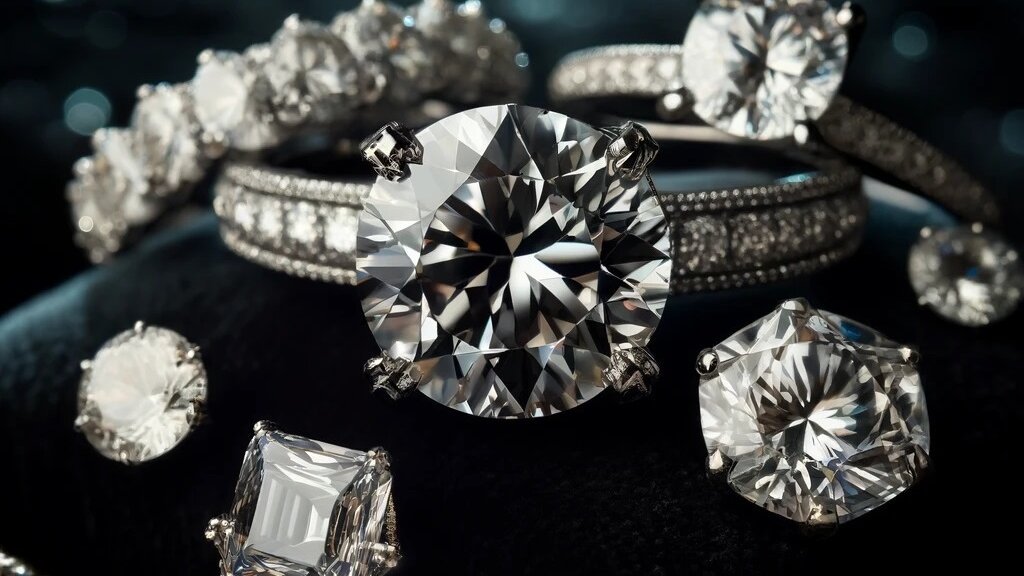
Comparing Diamond Simulants
These tables provides a detailed comparison of various diamond alternatives, including their hardness, density, dispersion, refractive index, flawless nature, cost, color, and crystal structure, and will help you understand the unique characteristics and value of each option.
Table Part 1 of 2:
| Property | Diamond | Cubic Zirconia | White Zircon | Swarovski Crystal | Moissanite |
|---|---|---|---|---|---|
| Hardness | 10 | 8.5 | 7.5 | 6-7 | 9.25 |
| Density | 3.5-3.53 | 5.5-5.9 | 4.6-4.7 | unknown | 3.21 |
| Dispersion | 0.004 | 0.058-0.066 | unknown | unknown | 0.1 |
| Refractive Index | 2.42 | 2.088-2.176 | 1.92-2.01 | 1.5-1.7 | 2.65-2.69 |
| Flawless | Rare | Always | Rare | Always | Natural-rare / Synthetic-always |
| Cost | Highest | Low | Middle-High | Low | Middle-Low |
| Color | Various | Colorless | Colorless | Colorless | Colorless |
| Crystal Structure | Lattice | Cube | Tetragonal | unknown | Hexagonal |
Table 2 of 2:
| Property | White Sapphire | White Topaz | Zircon (not cubic zirconia) | Lab-Grown Diamond | Enhanced Diamond |
|---|---|---|---|---|---|
| Hardness | 9 | 8 | 6-7 | 10 | 10 |
| Density | 4 | 3.5 | 4.6-4.7 | 3.5-3.53 | 3.5-3.53 (variable) |
| Dispersion | 0.018 | 0.014 | 0.039 | 0.004 | 0.004 (before treatment) |
| Refractive Index | 1.76-1.77 | 1.62-1.63 | 1.92-2.01 | 2.42 | 2.42 (variable) |
| Flawless | Rare | Rare | Rare | Rare | Rare (variable) |
| Cost | Middle-High | Middle | Middle-High | Middle-Low | Much Lower than untreated |
| Color | Colorless | Colorless | Colorless | Various | Various (improved) |
| Crystal Structure | Hexagonal | Orthorhombic | Tetragonal | Lattice | Lattice |
Cubic Zirconia vs Diamond
Cubic zirconia’s key traits make it a poor choice in comparison with diamond. It won’t sparkle anywhere near as brightly, and will very easily reveal itself to be inferior to diamond.
Durability and Longevity
Not only does cubic zirconia look inferior to diamond when it’s brand new, but it is also incapable of looking good after regular wear. For most people, it will need to be replaced within a year of regular wear, meaning that it’s not even a good choice for a temporary engagement ring.
Moissanite vs Cubic Zirconia
Neither are ideal. For fashion jewelry, moissanite is a better choice as a result of its higher refractive index, which makes it a more impressive gemstone, and its superior strength.
Moissanite vs Diamond
Moissanite doesn’t enjoy the same high status or lofty reputation of diamond, so it’s not for everyone.
Another factor to consider when you’re thinking about diamonds vs diamond simulants is that many, many jewelers continue to work solely using diamond and other precious gemstones. Moissanite remains more of a niche interest in the jewelry world, so shoppers often struggle to find excellent jewelers in their area working with moissanite as well as diamond.
It’s certainly not impossible, but it’s nowhere near as easy.
Price Considerations
Moissanite is more expensive than cubic zirconia. A one carat moissanite will cost between $500 – $600, while a cubic zirconia of the same weight will cost less than $20.
Even jewelry intended to be worn once in a while, and not intended to hold any strong sentimental value, is better off if it is created from durable materials. So, if you’re looking for a piece of quality costume jewelry, we’d recommend moissanite over cubic zirconia.
For any special pieces, however – whether an engagement ring, eternity ring, or sentimental gift – neither moissanite nor cubic zirconia is worth the price. They might be capable of resembling diamond from a distance but, up close – and when worn day-in, day-out by your partner – the differences will be clear to see, even to a diamond novice.
Our Expert Take
Unless you’ve got a budget way above average, it’s only natural that you find yourself wondering about ‘diamond alternatives’, that will give you a lot more bang for your buck. Larger diamonds come at a much higher price, and plenty of shoppers start off with some grandiose dreams only to realize that the market saw them coming.
Cubic zirconia and moissanite are all over the internet – partly because of interest from shoppers, but also because the internet is the ideal place to sell something that, in a picture, looks just like diamond.
Don’t do yourself, your partner, or your wallet a disservice. Understand why diamond is the superior choice not just in terms of looks, but durability and sentimentality, too. Find a beautiful stone in your price range, and accept that there is a lot more to buying an incredible engagement ring than getting the biggest rock money can buy.
8 FAQs
- Q: What is the main difference between moissanite, diamond, and cubic zirconia?
A: Diamonds are natural, extremely hard gemstones formed over billions of years. Moissanite is lab-created, almost as hard as diamonds, known for brilliance. Cubic zirconia, also lab-created, is less hard and durable but more affordable. - Q: Can you visually tell the difference between these gemstones?
A: To the untrained eye, it can be challenging. Diamonds have unique brilliance, moissanite exhibits colorful fire, and cubic zirconia is less brilliant and prone to scratches. - Q: Is moissanite more durable than cubic zirconia?
A: Yes, moissanite is more durable, ranking closer to diamonds on the Mohs scale, making it more resistant to scratches and suitable for everyday wear. - Q: Are these gemstones eco-friendly?
A: Moissanite and cubic zirconia are considered more eco-friendly than mined diamonds as lab-created gems reduce the environmental impact of mining. - Q: Do moissanite and cubic zirconia have any resale value?
A: Generally, they have lower resale values compared to diamonds, which are often considered investments due to enduring value. - Q: How do I care for these different gemstones?
A: Clean with mild soap and warm water. Avoid harsh chemicals and extreme temperatures, especially for moissanite and cubic zirconia, to prevent damage. - Q: Are these stones suitable for all types of jewelry?
A: Yes, but diamonds are best for everyday wear like engagement rings, while moissanite and cubic zirconia are suitable for occasional wear or fashion jewelry. - Q: Which is the best option for an engagement ring?
A: Depends on preference, budget, and values. Diamonds are traditional and long-lasting, moissanite offers similar durability and sparkle at a lower cost, and cubic zirconia is affordable but less durable.
Discover the perfect diamond with Jeweler AI – bridging elegance and innovation in your engagement ring selection.
FOLLOW-UP GUIDE SERIES

